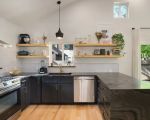
Transforming My Home with Rustic Style: A Journey Through Wood, Stone, and Soul
When I first laid eyes on our 1970s ranch-style house, I saw beyond the popcorn ceilings and linoleum floors. I saw timber beams, aged wood, and cozy textures—an authentic rustic retreat. Remodeling a home to reflect a rustic style isn't just about adding barn doors or reclaimed wood. It's about evoking warmth, simplicity, and a deep connection to nature. Let me take you through what I learned from remodeling my own home in a rustic style—and what you should keep in mind if you're planning the same.
1. Understanding the Heart of Rustic Design
Before you pick up a hammer or paintbrush, you have to understand what rustic style truly means. It's more than aesthetics—it's a philosophy. Rustic style embraces imperfection, raw beauty, and the charm of natural elements. I realized this while visiting a friend’s mountain cabin in Colorado. The rough-hewn beams, stone hearth, and handwoven textiles didn’t scream luxury, but they radiated a lived-in comfort that I instantly fell in love with.
Embracing Nature Indoors
One of the core elements of rustic design is bringing the outdoors in. For my remodel, I chose wide-plank wood flooring made from reclaimed oak. It had knots, uneven textures, and even nail holes—but that was the point. I also incorporated natural stone in the fireplace surround, using locally sourced granite to tie the design back to our landscape.
Colors That Reflect the Earth
Rustic design thrives on earthy tones—think warm browns, soft greens, charcoal grays, and creamy beiges. I painted the walls in a soft clay hue, which made the house feel grounded and serene. The key is to use colors that feel like they’ve been pulled straight from the forest or mountains.
2. Planning the Renovation with Purpose
Any successful remodel starts with a solid plan. I didn't jump into demo mode until I had a clear vision and a firm grasp on budget and materials. Rustic style might look simple, but achieving that effortless charm takes careful decision-making.
Choosing the Right Materials
I spent weeks hunting for authentic materials—reclaimed wood from old barns, handmade terracotta tiles, and vintage hardware. I avoided anything that looked too polished or modern. Instead, I found beauty in aged patinas and irregular textures. This search led me to a small salvage yard outside Austin, where I scored a stunning set of old cedar doors that became a centerpiece in the remodel.
Balancing Old with New
It’s important not to turn your home into a museum. I needed modern conveniences—an efficient HVAC system, updated wiring, and a functioning kitchen. The trick was to hide them behind rustic elements. We installed a state-of-the-art oven with an old-style cast-iron hood above it. The living room got a new entertainment system, but it was cleverly tucked inside a custom wood cabinet that looked like it came out of a 19th-century farmhouse.
3. Designing Each Room with Intention
Each room in a rustic home should tell a story. I approached the design room by room, carefully curating elements that complemented the overall rustic theme without being repetitive.
The Kitchen: A Rustic Heartbeat
My kitchen became the soul of the home. I went with butcher block countertops, an apron-front farmhouse sink, and open shelving made from repurposed beams. Copper pots hang from a wrought iron rack, adding both utility and charm. One of my favorite features is the old baking table I turned into a kitchen island—it still has the burn marks from years of use.
Living Room: Cozy, Layered, Inviting
In the living room, I focused on layers and texture. A large stone fireplace anchors the space, surrounded by a plush wool rug, leather armchairs, and vintage blankets. I installed dimmable lighting fixtures made from aged iron, which cast a warm glow in the evenings. Every detail mattered—from the hand-stitched curtains to the woven baskets that double as storage and décor.
Bathrooms and Bedrooms: Rustic Meets Relaxation
In the bathroom, I used pebble tiles in the shower and a weathered vanity topped with a vessel sink made of river stone. It feels like a spa hidden in a forest cabin. For the bedrooms, I chose wrought iron bed frames, soft flannel linens, and wood-paneled walls that echo old-school lodges. Even the nightstands were crafted from stumps I sanded and sealed myself.
4. Mistakes I Made—and What You Can Avoid
No remodel is perfect, and I learned a lot from my missteps. For instance, I initially used a dark stain on the ceiling beams, thinking it would make the space feel cozier. Instead, it made the rooms feel closed in and cave-like. I ended up sanding them down and re-staining with a lighter, more natural finish. Lesson learned: test colors and finishes in real light before committing.
Another challenge was sourcing consistent reclaimed materials. Matching tones and textures across rooms can be tricky when dealing with salvaged goods. I recommend purchasing extra material when possible and working closely with suppliers who understand the rustic aesthetic.
5. Living the Rustic Lifestyle
Once the remodel was complete, it wasn't just about the look—it was about the lifestyle. I found myself slowing down, enjoying mornings with coffee by the stone hearth, and hosting friends for wine and conversation under soft lighting and exposed beams. The rustic style fosters a sense of ease, comfort, and connection—something deeply needed in today’s fast-paced world.
If you’re dreaming of transforming your home into a rustic haven, take your time, embrace imperfections, and make choices that tell your story. Trust me—there’s nothing like coming home to a space that feels as natural and warm as the woods themselves.








